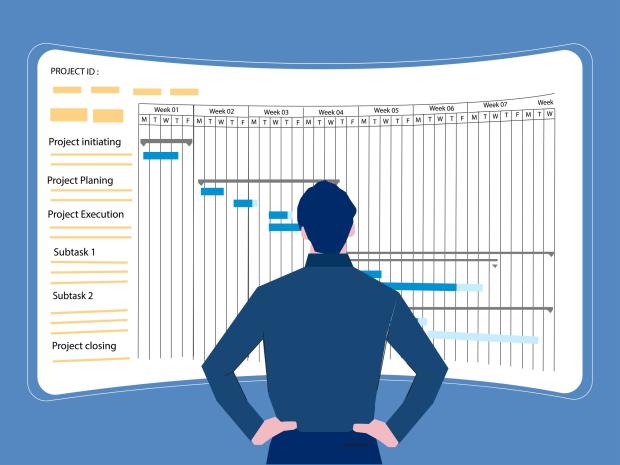Software project management is no simple task, and the keys to managing software projects efficiently and effectively may change dramatically from project to project. However, the 10 tips below can help software project managers of all kinds work smarter and get better results.
Top 10 Essential Tips for Software Project Management
1. Establish Clear Goals and Objectives Early On
Starting a software project without a clear set of goals is like embarking on a journey without a clear destination in mind. In its very definition of “project management,” the software developer Sovtech positions “defined goals and objectives” as the basis for all project planning, organization, and resource management activities.
2. Implement Agile Methodologies for Flexibility
A systematic framework that guides project management and facilitates team collaboration for enterprise software development, Agile is designed to boost efficiency, speed operations, and promote flexibility. Flexibility is crucial in software development because project managers in this field must quickly adapt to the demands of each individual project.
3. Prioritize Effective Communication Among Teams
It takes a sizable team of professionals with diverse areas of expertise to complete any significant software development project. This means that project managers must be committed to promoting the type of team communication that makes seamless collaboration possible.
4. Utilize Project Management Software to Streamline Processes
Fortunately, messaging platforms like Google Hangouts and file-sharing platforms like Google Drive can do wonders to help software development teams communicate and collaborate. This is only the tip of the iceberg when it comes to supportive project management software, though. Microsoft Project, Zoho Projects, and Asana are a few among many software platforms that help project managers with task management.
5. Foster a Culture of Continuous Learning and Improvement
Things change quite rapidly in the fast-paced world of tech. To stay ahead of the curve, a wise software project manager will commit to lifelong education to optimize their governing principles and procedures. Continuous learning makes managers far more able to respond to new problems and capitalize on emerging opportunities in software development.
6. Ensure Regular and Transparent Reporting

Mutual trust among team members is a core component of software development success — and full transparency is key to establishing trust. This makes frank and open reporting a must throughout the development process. Software developers should regularly report to project managers on the status of assigned tasks, and project managers must provide ongoing updates to team members, clients, and other project stakeholders. In the words of the software development AI company GitLab, “Committing to documenting decisions … demonstrates a default to transparency.”
7. Embrace Change Management Practices
Change management is also critical for effective software development. Simply put, this involves tracking and supervising changes to programming code and other essential elements of development. This typically requires the use of specific digital tools.
8. Allocate Resources Wisely and Efficiently
Because project managers always face certain operational limitations, resource allocation is a substantial part of the job. This often requires prioritizing certain project tasks and details over others.
9. Conduct Regular Team Meetings and Reviews
Regular team meetings and reviews are key to collaboration in the software development industry. In particular, GitLab emphasizes the importance of free and open code reviews to prevent any negative project impacts due to unstable code.
10. Evaluate Project Performance Post-Completion
Any project worth doing is worth following up on, and professional improvement doesn’t end with project completion. To ensure optimum performance for both your development teams and the software that they produce, final project evaluation is a must.
Diving Deeper Into Agile Project Management
We have already singled out Agile methodology as a key framework for promoting flexibility. But what exactly is Agile, and what management principles does it emphasize?
Understanding the Agile Framework
With a specific focus on software development, the Agile framework helps project managers adapt to changing professional demands and foster a collaborative working environment. It makes projects more manageable by breaking them into smaller phases called “sprints.” During each two- to four-week-long sprint, managers lead with a focus on clear direction, efficient processes, quality requirements, realistic timelines, and a culture of learning. In the article “How to Improve Your Agile Processes,” Taylor Bruneaux reports, “At the end of each sprint, teams aim to produce tangible, incremental deliverables, including a new feature implementation, bug fixes, or enhancements to the existing system.”
Benefits of Agile in Software Development
Beyond stressing adaptability and furthering collaboration, Agile provides a competitive advantage by focusing on specific customer needs. By encouraging feedback from all project stakeholders, Agile managers are in a far better position to optimize results.
Implementing Agile: A Step-by-Step Guide
To increase the chances of project success, wise managers take a systematic approach to Agile implementation that begins by ensuring all project stakeholders are fully on board with the Agile framework. An organized Agile kickoff workshop can be indispensable in these efforts.
Secondly, managers should assign clear roles and responsibilities to each team member with a dual emphasis on motivation and empowerment.
In addition, managers should establish a clear task flow and ensure that each team member knows their place within it.
Lastly, it is critical to put review and evaluation procedures in place to foster a culture of continuous improvement.
Agile Tools and Technologies for Effective Management
Agile management would be difficult, if not impossible, without the right digital tools. While different tools lend themselves to different projects and operational focuses, the most popular among them include Agile Manager, Jira, Trello, and Version One.
Effective Communication Strategies in Project Management
From advanced digital tools to basic speaking and writing practices, project managers can employ a range of strategies to improve communication among team members.
Tools for Enhancing Team Communication
Aside from Google Hangouts, other helpful digital tools that drive and supplement collaboration and communication among team members include platforms like Google Meet, Slack, Microsoft Teams, and more.
Overcoming Communication Barriers in Remote Teams
Teams that are separated geographically face unique challenges in the realm of software development and beyond. Using a common communication platform that meets the unique demands of your project can go a long way in combating remote work problems. Additionally, you should double down on your efforts to establish clear and consistent processes for projects as well as solicit constructive feedback from your team members to ensure everyone’s needs are met.
Best Practices for Maintaining Clear Communication
Beyond the effective communication techniques already mentioned, the National Society of Leadership and Success and numerous other organizations recommend following the “Seven C’s of Communication.” Regardless of the message and how it is conveyed, you must strive to be clear, concise, concrete, correct, considerate, complete, and courteous in your communications.

Building a Culture of Continuous Improvement
A close cousin to Agile management, Lean management places a concerted focus on continuous improvement. Drawing upon Lean principles, the business software company The Lean Way has published 11 steps to building a culture of continuous improvement. These steps are:
Setting goals
Communicating those goals
Establishing a framework for improvement
Spreading awareness of this framework
Engaging your team
Optimizing communication among team members
Prioritizing important initiatives
Setting evaluation standards
Celebrating successes
Creating new habits
Repeating this entire process as necessary
Techniques for Encouraging Team Feedback
First and foremost, you can encourage feedback by remaining actively engaged with your team at all times, meeting regularly, spearheading team-building activities, and providing constant updates. Popular methods of soliciting feedback include surveys and face-to-face interactions. You should take care to offer opportunities for team members to give feedback privately and/or anonymously.
Implementing Lean Principles in Project Management
In addition to being a close cousin to Agile methodology, Lean methodology is often used in conjunction with it. Lean principles concentrate on eliminating wasted resources and time to deliver additional value. The Lean Suite lists the five key principles of continuous improvement as:
Making small changes
Soliciting ideas from team members
Making team members accountable for improvement activities
Aligning improvements with strategic goals
Making improvements measurable and repeatable
Success Stories of Continuous Improvement
A software development company that specializes in Lean management, KaiNexus stays up to date with the major companies that have benefited the most from a firm commitment to continuous improvement. It considers Toyota and Amazon to have the most compelling continuous improvement success stories in history.
Toyota has long been a leader in the development and implementation of Lean methodologies. In fact, the company is responsible for creating many core continuous improvement techniques that are incredibly popular today. Toyota’s Just-in-Time (JIT) approach, for example, drives improvement by eliminating waste in numerous ways. The heart of JIT is manufacturing and delivering products only when and where they are needed.
Amazon has fostered a deep culture of continuous improvement in a range of ways. Much of this culture is centered on better understanding and meeting specific customer needs. Its approach to problems and challenges also drives continuous improvement. “Amazon embraces failure as a learning opportunity rather than a setback,” writes KaiNexus. “The company recognizes that not all ideas will succeed but views failures as stepping stones to future success.”
Tools and Resources for Measuring Improvement
Many of the Agile and general team collaboration tools above provide exceptional resources for measuring continuous improvement in project management, processes, and operations. However, countless digital tools on the market cater to various project management approaches. In her article “Leveraging Tools to Measure Developer Productivity,” DX’s Taylor Bruneaux recommends Azure DevOps and Monday.com to monitor continuous process improvements.
Advance Your Software Project Management Skills
If you are serious about excelling as a software project manager, consider pursuing an advanced degree in the field — such as the software engineering and project management master's degree program at Champlain College Online. Contact the admissions department today for further information.
Frequently Asked Questions
Beyond strong general management and leadership skills, software project managers must be exceptional communicators and have a solid command of relevant technical issues. Risk management, time management, and problem-solving are other key aspects of the profession.
In managing software projects, Agile emphasizes flexibility and collaboration to make software development processes and operations as streamlined as possible. The end result is added value for project team members, clients, and final software users alike.
The first step on the journey to a successful career as a software project manager is to pursue a relevant college degree that demonstrates an appropriate mix of technical and management knowledge and skills. You may also need to secure one or more professional certifications and learn to use any number of digital platforms or tools.
You May Also Like

Blog Topics





